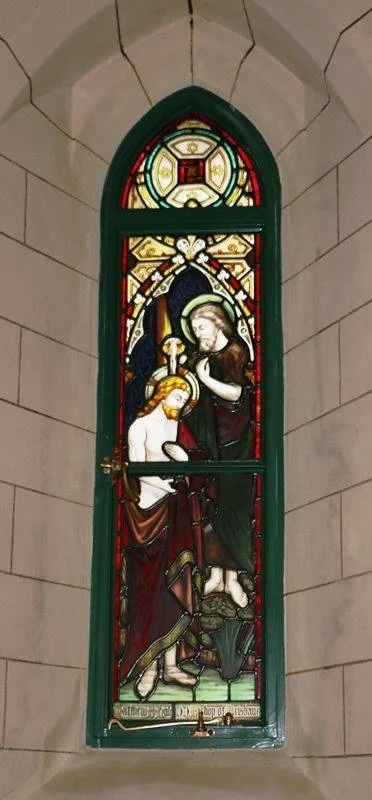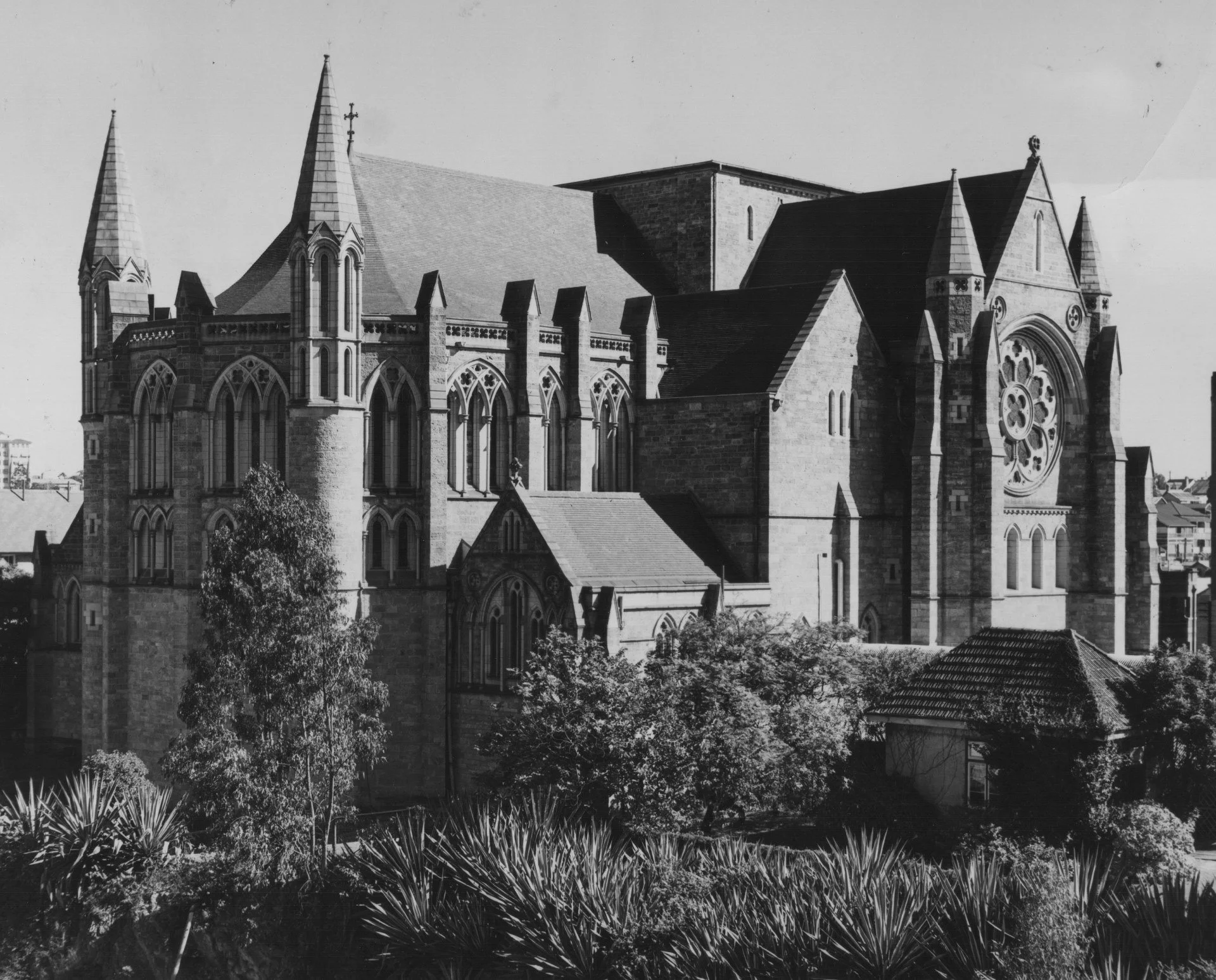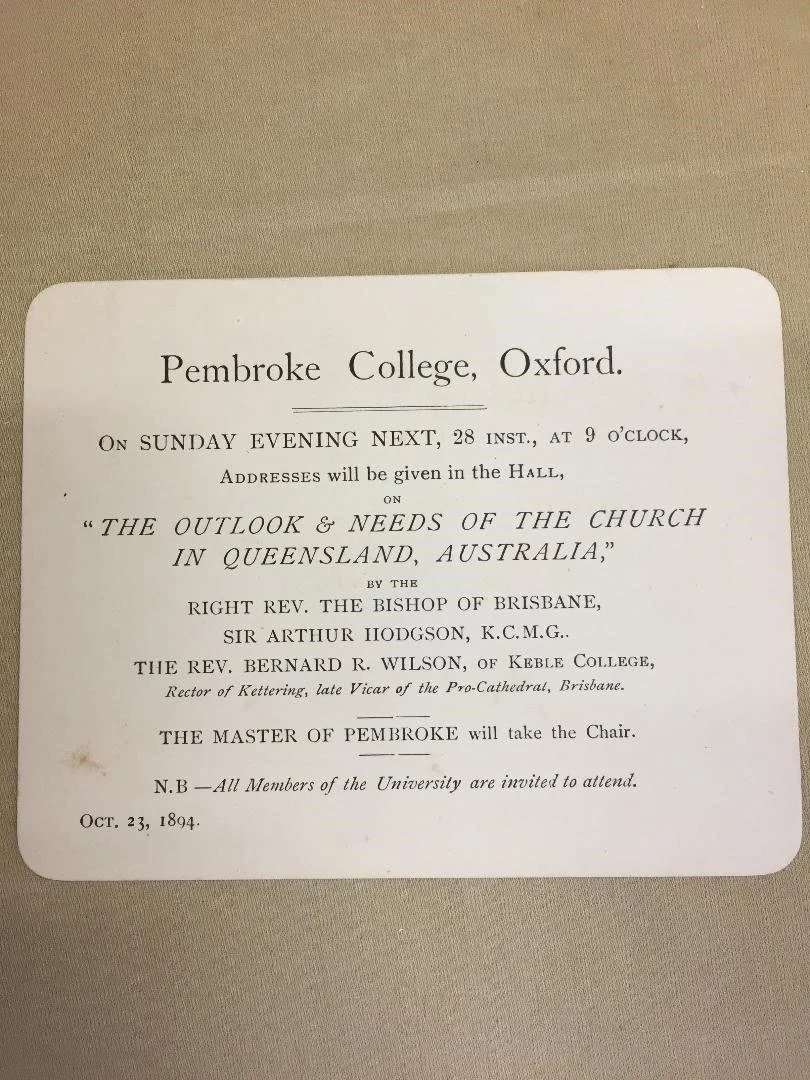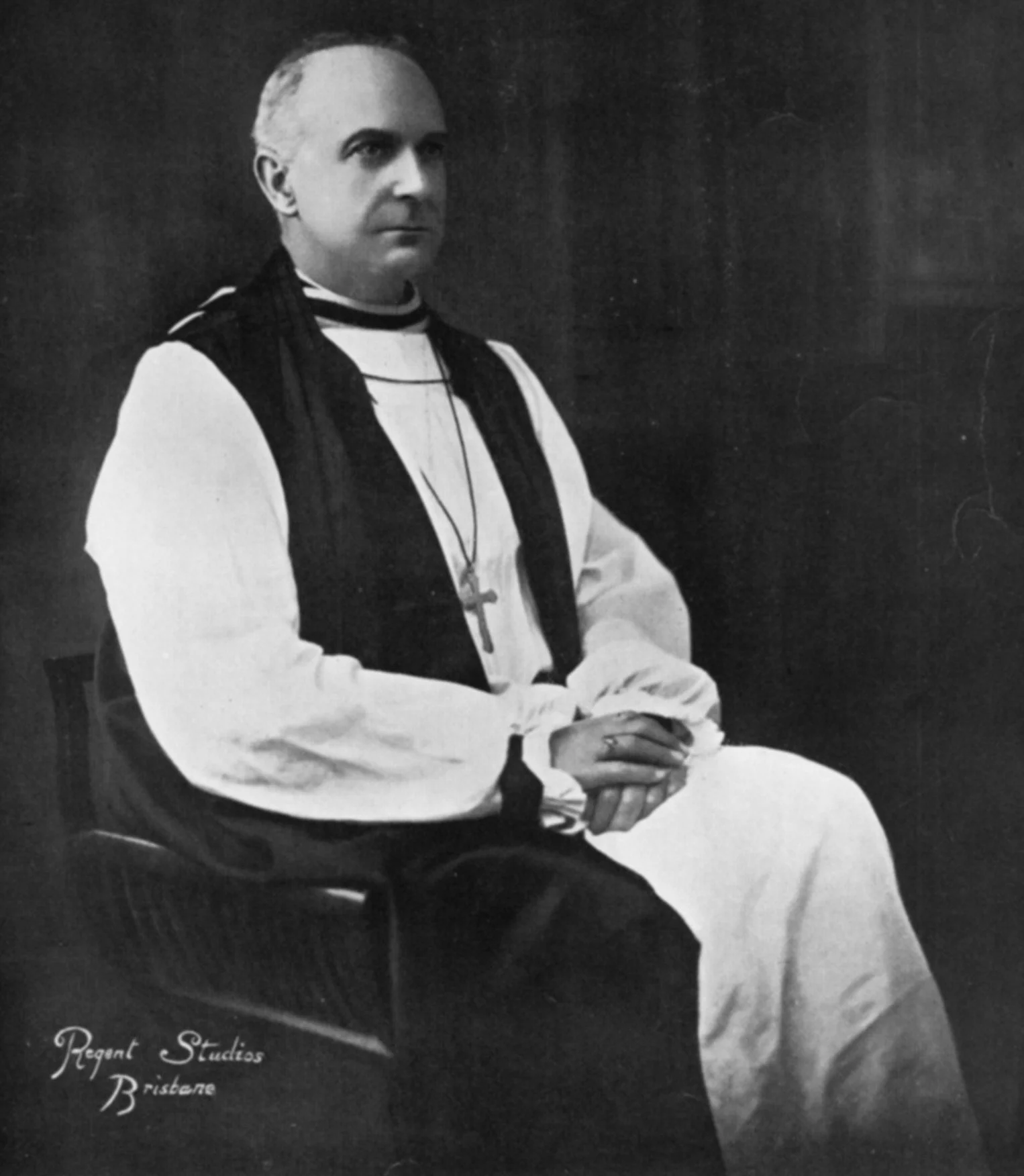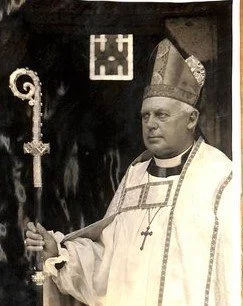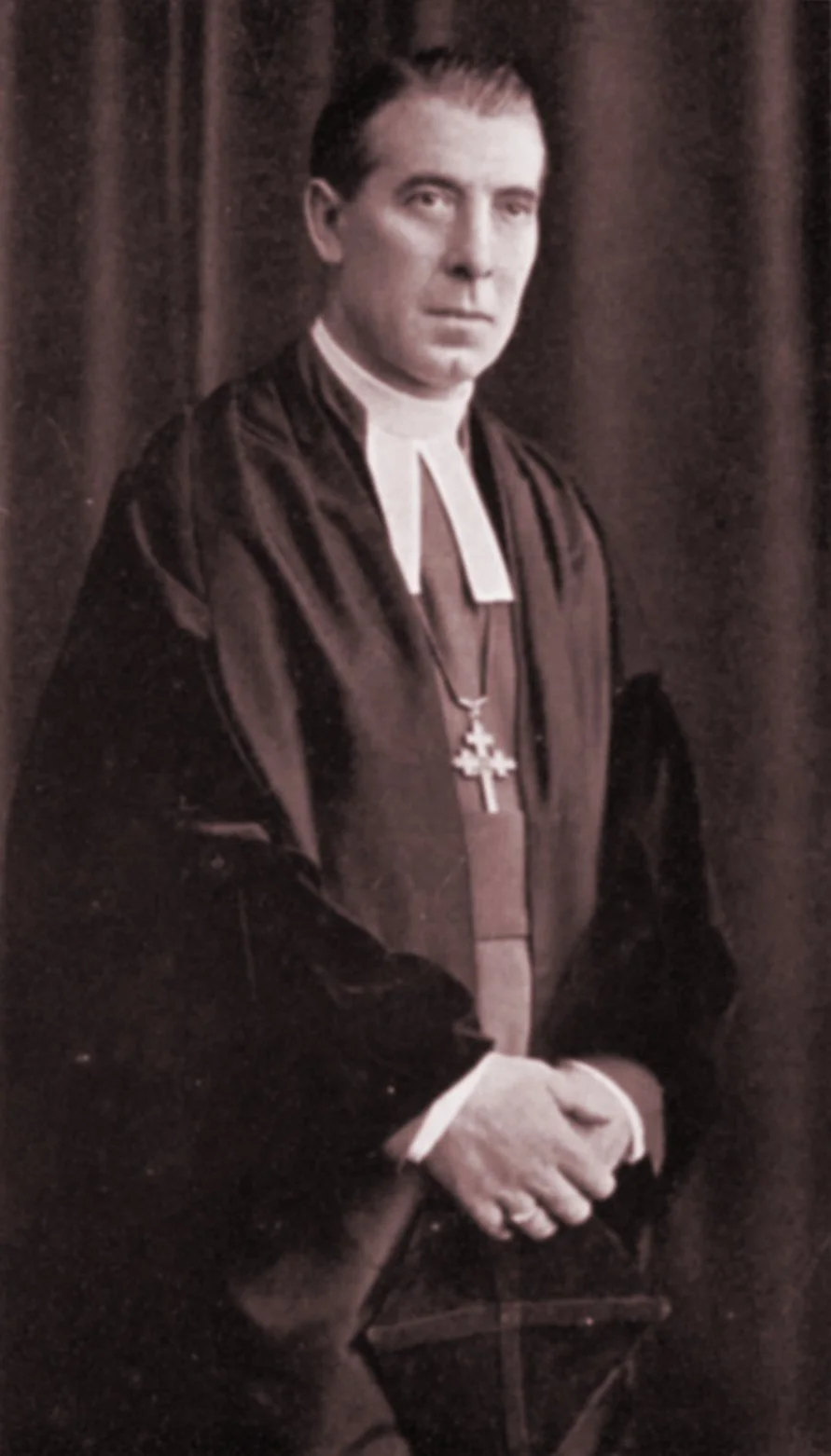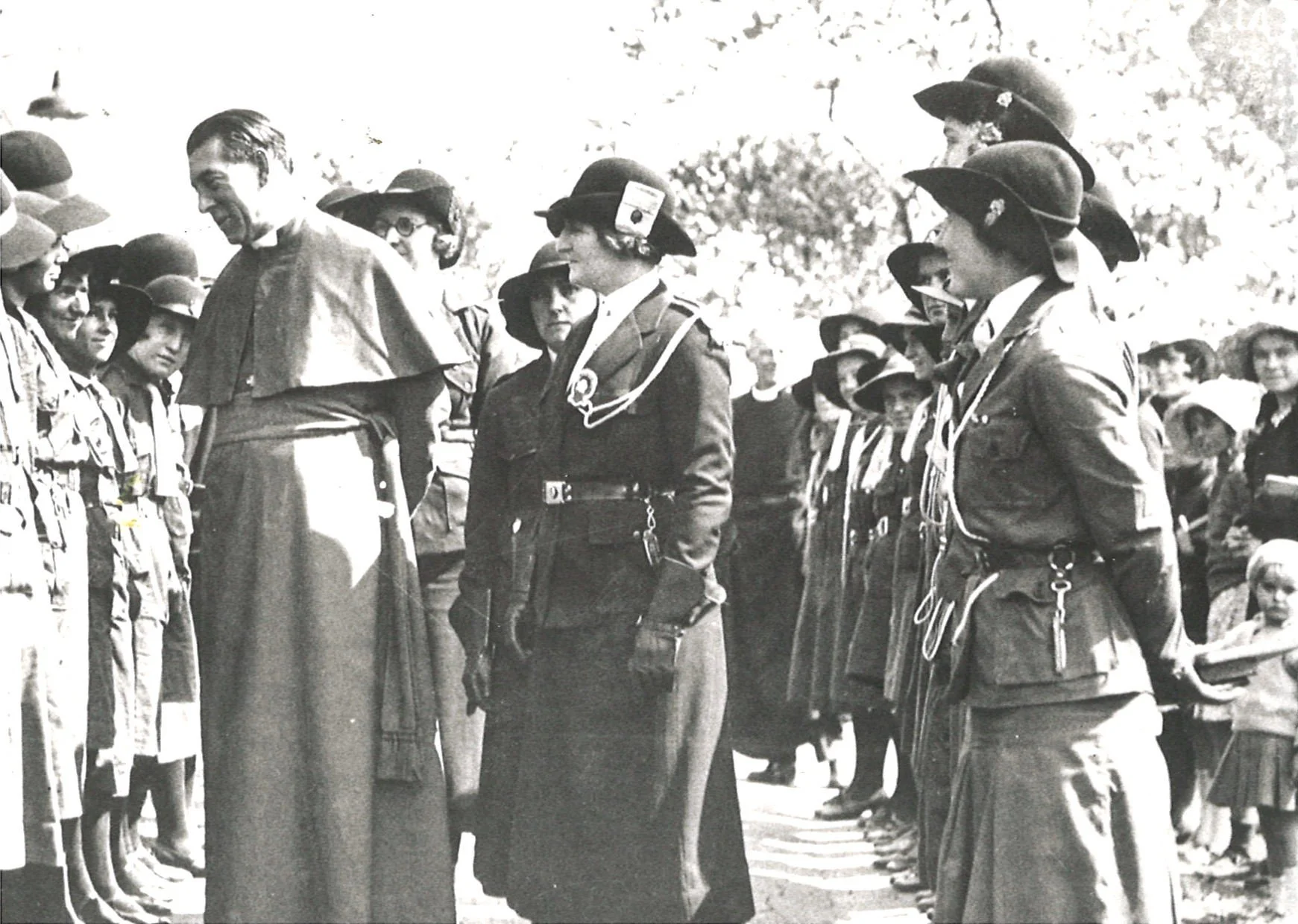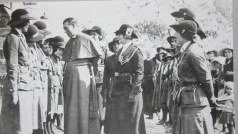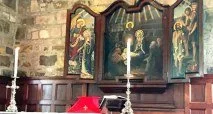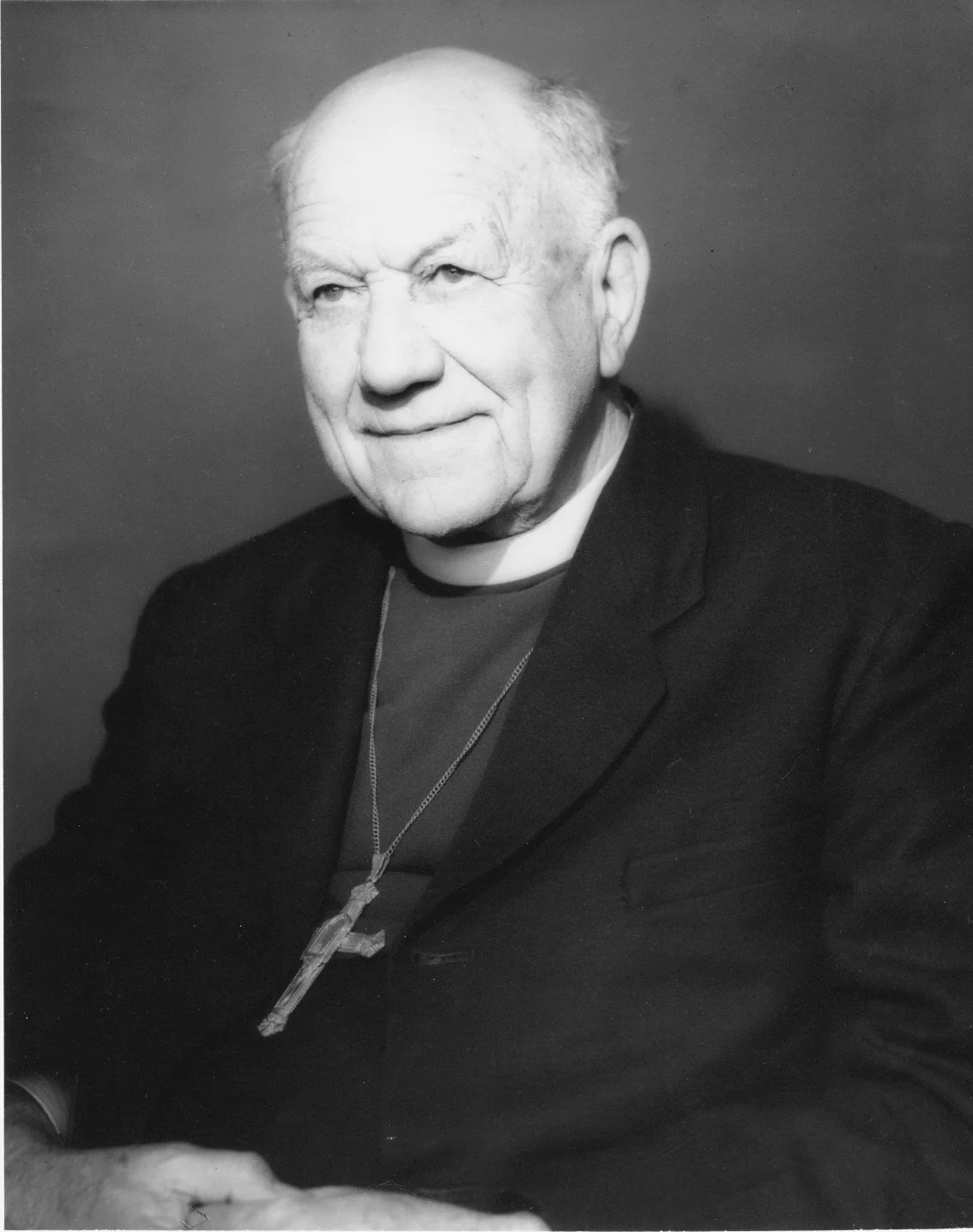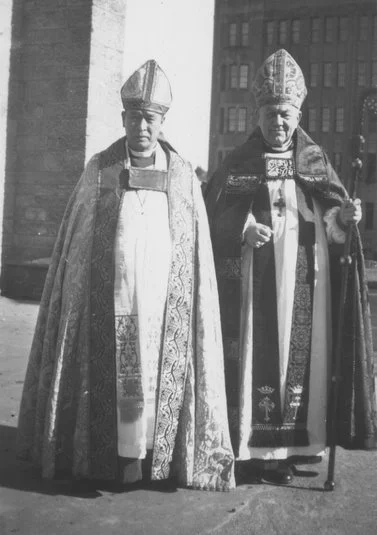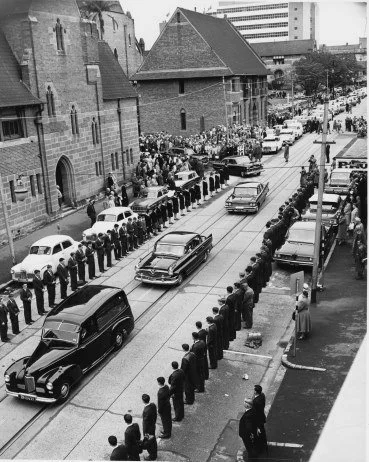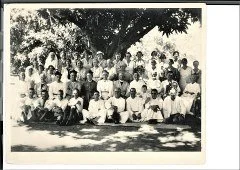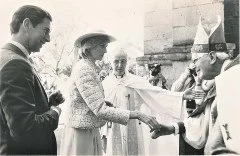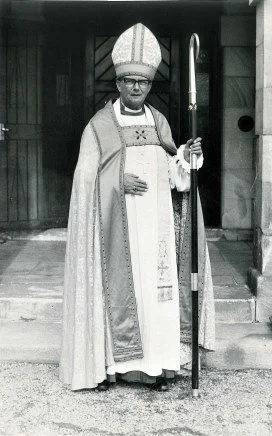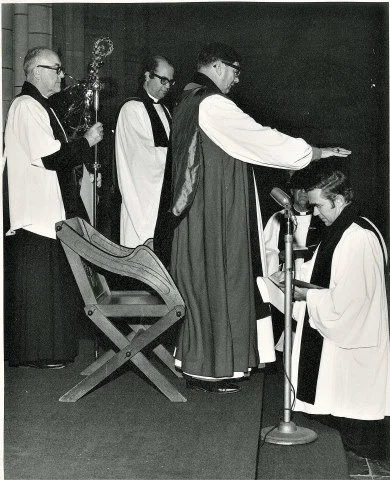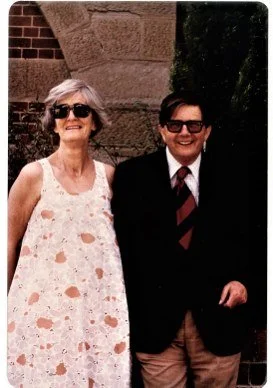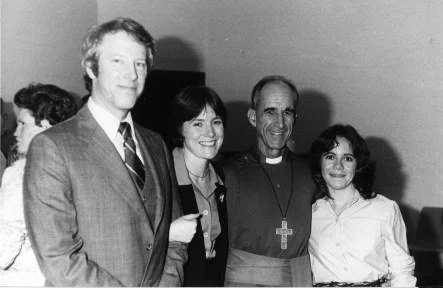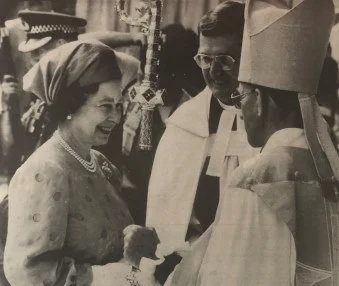
Bishops and Archbishops
Beginnings…
Although the Moreton Bay Penal Settlement was established on the banks of the Brisbane River in mid 1825, there were few Church of England priests who ventured north from Sydney, and services were often held by civilian surgeons. One of the first priests was Rev'd Johann Christian Simon Handt in 1837, although his was not an official appointment and had been sent out to the colony of New South Wales by the Church Missionary Society to work amongst the Aborigines in Moreton Bay. When Moreton Bay was about to be redesignated a free settlement, Bishop Broughton (the Bishop of Australia) appointed the Rev'd John Gregor - with the licence to take up duties from the 1st January 1843. Having no access to a designated chapel or church, Gregor secured a workshop shed in the Military Barracks situated in North Quay. He took residence at the Moravian Missionary Station at German Station, later called Nundah (a long trek), however it appears not to have dissuaded Gregor from performing his duties - as Bishop Broughton noted at the time: "the distinct evidence of the laborious zeal with which Mr Gregor devotes himself to convey the glad tidings of redemption to those far separated members of Christ's body, who but for such exertions to reach them, must be hopelessly cut off..."
Further information on Rev'd John Gregor - anglican focus article
Rev'd Benjamin Glennie and his wife
On the 22nd January 1848, seven days before Bishop William Tyrell (the new Bishop for New South Wales) arrived in Sydney, Gregor drowned in a water hole - not far from the Mission station in Nundah. Tyrell had been appointed to oversee the new Diocese of Newcastle (of which Brisbane was part of until 1859), and immediately saw the necessity of appointing a replacement for Gregor. The appointment was made from one of Tyrell's accompanying band of clergy - Rev'd Benjamin Glennie - who took up the appointment on the 25th March 1848. Glennie was a Deacon when he arrived in Brisbane, but was ordained as priest in 1849. Tyrell visited a few months later in June 1850 to bless the laying of the foundation stone for St. John's Church in William Street, and again in 1854 for the consecration of St. John's, which served as the Pro-Cathedral until 1904. Tyrell also oversaw the establishment of the parishes of Wide Bay and the Burnett (headquartered at Maryborough), and also appointed Rev'd Henry Irwin to Brisbane in 1850 - allowing him to transfer the able Glennie to the Darling Downs where he ministered with distinction for over 25 years.
Bishop Tufnell - the first Bishop of Brisbane
A Portrait of Bishop Tufnell located at the National Portrait Gallery in London
The establishment of the new colony of Queensland on the 10th December 1859 also saw the establishment of the new Diocese of Brisbane. The proclamation of the new colony was made by Governor Bowen on the balcony of Adelaide House - now the Deanery in the current Cathedral Precinct. The first Bishop for the Diocese, Edward Wyndham Tufnell, was consecrated at Westminster Abbey on 14 July 1859 and arrived in Brisbane on the 2nd September 1860 with a 'band' of six clergyman, all of whom shared Tufnell's moderate High Church and were influenced by the Oxford movement promoted by Denison and Hamilton (both whom became at one time Bishop of Salisbury). He was enthroned on the 4th September 1860 at St. John's Church.Tufnell oversaw the rapid extension of parish ministry throughout Queensland, and was a key driver in the establishment of synodical government (the first General Synod for the Diocese was held in September 1867) and placing the Diocese on a sound financial footing. Tufnell and his family left Brisbane in February of 1874, going to Singapore and then on to England. He died on 3rd December 1896 at Chichester and is buried in the Feltham churchyard.
Bishop Tufnell and “Tufnell’s Band” of clergy at the foundation of the Diocese
Significant events during this period include the establishment of the Corporation of the Synod in 1870, the opening of the Brisbane Female Refuge (also in 1870) by Mrs Ann Drew, and the construction of All Saint's Wickham Terrace - the oldest existing Anglican church in the Diocese - in 1869. He was also responsible for funding and overseeing the building of Bishopsbourne in Milton in 1867/68. Tufnell handed this over to the Diocese to act as a residence for future Bishops of Brisbane. It remained as such until the mid-1960s. During Tufnell's time as Bishop, the Bishop of Newcastle handed over the deeds for more than 20 pieces of land within the Diocese upon which many Churches were built.
Bishop Mathew Hale
Stained Glass Window dedicated to Bishop Hale in Christ Church, Bundaberg
Ann Drew’s Women’s Refuge c. 1885
Mathew Hale was ordained a priest in 1837, serving mainly English parishes. In 1847 he was invited by the Bishop of South Australia (Augustus Short) to become an archdeacon in that colony - where he served until 1855. After a short trip back to England, Hale returned in 1857 to be the first Bishop of Western Australia.
While the first Bishop of Brisbane (Bishop Tufnell) had been appointed by the Crown, it was now up to the Diocese and the Synod to choose the second Bishop. A special session of the Synod in November of 1874, with Benjamin Glennie presiding, failed to choose someone and so the decision was left to the nation-wide 'Bench of Bishops'. It was the Bishop of Adelaide, in accordance with being the Primate of Australia, who suggested Hale, even though (by this time) he was already 64 years of age.
In 1875, Hale was appointed the second Bishop of Brisbane - serving until March 1885. During this period, he worked hard to connect remote districts and increase the number of clergy in the Diocese. He also oversaw the establishment of the Clergy Widow and Orphan's Fund. He was recognised by all as a devout and passionate follower of Christ, but his evangelical theology was at odds with many of the Oxford Movement clergy that had come to Brisbane under Tufnell's episcopate. Hale invited clergy of more evangelical tendencies to the Diocese and many came. Not many stayed, however, and the catholic-minded Anglicanism that came with Tufnell would return after Hale left the Diocese.
A talk at Matthew Hale Public Library
During Hale's episcopate the Diocese suffered great financial hardship. This lack of funds meant that Hale's desire to expand Churches and get clergy out to the more remote regions of the Diocese usually went unfulfilled. In 1880 Bishop Hale even offered to let out Bishopsbourne so the Diocese may have some income coming in and he would move to a less expensive residence. He nonetheless tried to achieve with personal action what he perhaps could not with additional funds. He was an avid supporter of the YMCA, and the RSPCA, and championed a deep sense of ecumenical outreach. So much so that, at his public farewell, members from the Presbyterian, Wesleyan, Lutheran, Scandinavian, Primitive Methodist, Congregational, and Baptist Churches were all present.
Before he left in 1885, Hale had moved (through Synod) that the process to select a new Bishop should begin when the old Bishop announces his intention to resign, not once he had left. He also suggested that, if needed, the Synod could pass responsibility for selecting a new Bishop to the Archbishop of Canterbury. So it was that the Synod asked the Archbishop of Canterbury to choose the successor to Bishop Hale.
Bishop Hale is commemorated within the Diocese with the Mathew Hale Public Library, associated with St. Andrew's Church South Brisbane, that celebrates his evangelical work and his outreach to the Aboriginal community. Mathew Hale died in 1895 and is buried in a churchyard at Alderley, Gloucestershire.
Bishop Webber and the Cathedral
Bishop Webber
The first stage of St. John’s Cathedral
Webber saw his task as Bishop as four-fold: to create the See of Rockhampton; form a Mission Chaplain’s Fund; bring clergy out from England; and supply pastoral care to outlying districts. More broadly, he wanted to create, in Brisbane, a proper Diocesan structure. He could be said to have achieved all of these tasks, raising thousand of pounds to create the Diocese to the North, and bringing a unity to the Diocese in terms of financial administration and governance, the creation of a Coadjutor Bishop, responsible mainly for the regions, and rural deaneries.
William Thomas Thornhill Webber was selected by the Archbishop of Canterbury to be the third Bishop of Brisbane. He was consecrated on 11 June 1885 in St Paul's Cathedral, London, and enthroned in Brisbane on 17 November 1885 at St John's Pro-Cathedral, Brisbane. Prior to this, he had been the Vicar at St. John's, Holborn for 20 years. During those years, he had transformed an impoverished Parish into a great one - raising funds to build churches and schools, holding many services each week for over 5000 parishioners and spreading the faith throughout the Parish and beyond. It was this experience and zeal that Webber brought to Brisbane, and perhaps no Bishop or Archbishop has had a greater impact than Webber on the Diocese. the day after his enthronement, he presided over his first Synod, stating of the church's role: "We must turn the light of Christian ethics upon the great social questions and problems of the day....[the church had] a duty of care for the nation's life."
An example of the fundraising activities of Bishop Webber
The re-interment of Bishop Webber’s coffin from Toowong Cemetery to underneath the altar in St. John’s Cathedral in 1910
In four years Webber increased the number of clergy in the Diocese from 34 to 61. These priests were all from England and all, like Webber, sympathetic to the Oxford Movement and the revival and outward expression of sacramental life. In 1892, with the help of Montagu Stone-Wigg, he established the Society of the Sacred Advent within the Diocese. In 1901 Webber oversaw a small community house of brothers being formed in Gayndah. This was the forerunner to the Bush Brotherhood. In 1893 he established The Theological College in Brisbane at All Saints’ Wickham Terrace. This later became St. Francis Theological College and in 1899 the Council of Education was duly constituted and formed. His forte, however, was fundraising, making several trips to the UK to raise an enormous amount of money for the Diocese but, in particular, for a project that was Webber's passion, perhaps even his greatest achievement, a neo-gothic Cathedral in the middle of Brisbane.
If one asks what was William Webber's greatest and most lasting impact on the Diocese of Brisbane, one needn't look further than St. John's Cathedral. From the start, Webber looked to establish a true Gothic Cathedral in the style of the one in Truro, England - and he travelled to England on four separate occasions to raise funds for its construction. In total, he raised over 100,000 pounds (over $22 Million in today's money). Webber commissioned JH Buckeridge to find a site for the new Cathedral - the present site between Adelaide and Ann Streets being obtained. The designs and plans were completed by John Pearson and refined by his son Frank Pearson. Webber lived long enough to see the Foundation Stone laid in 1901 by the Duke of Cornwall and York (who became George V), but he died in 1903 before the first stage could be completed. Upon the completion of that first stage of the Cathedral in 1910, the body of Webber was transferred from his original grave in Toowong Cemetery and re-interred under the main alter in the Cathedral Sanctuary.
A cartoon about Webber seeking to raise funds in England
The completion of the first stage of the Cathedral (from Commemorative edition of Church Chronicle November 1910
Donaldson - the first Archbishop
Archbishop Donaldson at the time of the consecration of Bishop Halford of Rockhampton in 1909
A group of Military Chaplains and Officers at the front in WWI, including, far right, seated, Rev’d Cecil Edwards, one of the Chaplains that Donaldson championed from the Diocese of Brisbane.
St. Clair George Alfred Donaldson was born and raised into a privileged English family, he was educated at Eton and Cambridge and yet he was the first person to lead Brisbane who had a connection with Australia. His father had owned land in NSW and for a short time was Premier. He had been a priest for many years in England before being chosen (again by the Archbishop of Canterbury) as Bishop of Brisbane and being enthroned on 21st December 1904 at St. Luke's Mission Church (now the Pancake Manor in Charlotte Street) which had become the Pro-Cathedral for the Diocese. Donaldson was the third and last presiding Bishop of Brisbane as, on 9th November 1905, Donaldson took the title of Archbishop of Brisbane and Metropolitan of the Province of Queensland. This province included the Diocese of Brisbane, Carpentaria, North Queensland, and Rockhampton.
During Donaldson's tenure as Archbishop, he worked hard to improve working conditions for the clergy and in 1905 took the Church to the bush by expanding the fledging bush brotherhoods (Brotherhood of St. Paul's) by introducing a regulation that a newly appointed priest had to spend the first five years wherever the Archbishop sent them. While Webber had brought many clergy to Australia from the UK, Donaldson was determined to train home-grown clergy, so that there could be a robust National Church in Australia. It also fell to Donaldson to see the Diocese through the turmoil that was the First World War. He believed passionately in the justness of the war and the call of the British Empire.
This manifested itself in a most obvious way in his spearheading, along with Canon Garland, the use of Chaplains both on Troop Ships and at the Front. After the war, Donaldson oversaw the first stage of construction for the St. Martin's War Memorial Hospital, open in 1921 (now used for offices by Cathedral and Diocesan officials).
Donaldson's tenure also saw the establishment and purchase of church schools - including the Church of England Boys School in East Brisbane (now the Anglican Church Grammar School), and the Southport School (established in 1901 by Canon Dixon). He left the Diocese in 1921 to return to England and became the Bishop of Salisbury. He stayed interested in matters relating to Brisbane and the Australian Church. He is said to have assisted in making William Wand become Archbishop of Brisbane in 1934, and when he died on 7th December 1935, he left a large bequest to the Diocese of Brisbane.
Archbishop Sharp
Archbishop Sharp with Crozier
Archbishop Sharp with Bush Brothers in 1926
Gerald Sharp was enthroned as Archbishop of Brisbane on 16th November 1921, after eleven years as the Bishop of New Guinea. He was very much of the Anglo-Catholic tradition, more so than his predecessor. He was inclined towards spiritual rather than intellectual theology and grew to be loved by many for his simple and self-evident piety. This did not necessarily mean he was the best administrator, often leaving the day to day running of the Diocese (especially in those early years) to the Coadjutor Bishop Henry Le Fanu. Nor was he a strong disciplinarian, and when confronted with issues like whether the Diocese of Brisbane should be seen as a High Church Diocese, or a low Church one, he tried to reconcile the sides and assert it was neither, even though he was strongly High Church himself. He strongly believed in the connection between the Church and morality, and condemned things like drunkenness and gambling. During the 1928 national strike action by waterside workers (which resulted in some violence) Archbishop Sharp invited the Roman Catholic Archbishop of Brisbane, James Duhig, and representatives of the Presbyterian, Methodist, Congregationalist, and Baptist Churches within Brisbane to Bishopsbourne to agree a joint statement calling for Industrial peace.
Partly as a result of the First World War, and an attempt to ensure the financial stability of the Diocese, 53 new churches were built and new real estate was purchased. Sharp oversaw the completion of St. Martin's Hospital and the Seaman's Mission (Mission to Seafarers) both of which had commenced in his predecessor's time - and also saw the establishment of Slade School at Warwick by the Bush Brotherhood of St. Paul's.
His belief in the importance of the Bush Brotherhood was paramount. He believed it to be 'the most attractive and valuable work in the diocese'. Other educational institutions established during this period included the Warwick Girls School (later St. Catherine's), the Toowoomba Boys School (later, Toowoomba Prep) and St. John's College at the University of Queensland.
During the 1930s, when the effects of the Great Depression began to bite, there were often a shortage of Rectors and many Parishes could not afford to pay the recommended stipend to their Priest. To help alleviate the pressure on church finances, Sharp surrendered one quarter of his salary during the Depression. The Depression also meant that the large amount of money spent on the building programmes of the 20s came to haunt the Diocese, and it fell further into financial distress. Again, Archbishop Sharp struggled with this, especially as Bishop Le Fanu left Brisbane to become Archbishop of Perth. He was also ailing in his health. On the 30th August 1933 Gerald Sharp, who never married, died of renal failure while still in office as Archbishop. It had been a long illness which he faced with characteristic spiritual fortitude. Upon his death Roman Catholic Archbishop James Duhig described him as, 'The most loveable man I knew'. He is buried at the Toowong Cemetery.
Archbishop Wand
Archbishop Wand leaving St. John's Cathedral after Anzac Day Service 1937
His background at Oriel perhaps influenced his style, as it has been said he had the attitude of a Headmaster. He attempted (with mixed success) to improve the intellectual quality of the clergy and attempted to wrestle overall control of the church schools from the school councils. He also arranged for the relocation of St. Francis Theological College from Nundah to its present site in Milton and succeeded in having the Senate of the University of Queensland introduce Biblical Studies to its curriculum. He wrote many articles and letters to the Courier Mail and regularly used radio to bring the Church to the people.
Link to an article about the death of Archbishop Wand's son Paul
Selection of articles from Qld newspapers (from National Library TROVE database).
Archbishop Wand inspecting Girl Guides at St. Mary’s Kangaroo Point c. 1940
Altar at the Chapel of the Holy Spirit, Old Bishopsbourne, Milton
John William Charles Wand was a fellow and Dean at Oriel College (Oxford) prior to being appointed to the Archbishop of Brisbane in 1934. He was consecrated at St Paul's Cathedral London on 1st May 1934, and was enthroned at St. John's Cathedral on 5th September 1934. His time in Brisbane began with tragedy, as he discovered within two weeks of his enthronement that his son, Paul, had died while climbing Mont Blanc, in the Swiss Alps. An image of Paul Wand can be seen as one of the shepherds in the Triptych that stands above the altar in the Chapel of the Holy Spirit on the grounds of old Bishopsbourne, at Milton.
Unlike predecessors like Donaldson, and despite his reputation as an aloof English gentleman uncomfortable in the colonies, Wand came from quite humble beginnings, his father being a Butcher. It meant he had a little better understanding of the people he was now to be the spiritual leader of than some of the previous Metropolitans. He had been, nonetheless, educated at Oxford, and excelled at academics. Far more used to the spires and cloisters of Oxbridge, coming to Brisbane was somewhat of a culture shock, though he had a connection with Australia. He had been sent, as a Chaplain, to Gallipoli in 1915, and had served as Chaplain to the Second Australian Hospital. Ironically, he was called upon again to deal with such international turmoil, as he led the Diocese through the first four years of the second world war. At first the Diocese coped well, as there were record numbers of clergy in Brisbane during Wand's episcopate, so some going off to serve as Chaplains could be handled, but when Japan entered the war in 1942, things became harder, with Church schools and Children's Homes having to be evacuated, and the Diocese losing more and more clergy to the war effort. Wand presided over these challenging times with great calmness, asserting that to panic would be, '...unworthy of both our race and of our religion' in a letter to the Diocese.
As the effects of the Depression lessened, the finances of the Church had improved. By the time Wand left in July of 1943, the Cathedral was debt-free and new churches and buildings were being built. Although not popular with certain politicians and parishioners, he left the Church in a much better state than when he first arrived. The British Prime Minister, Winston Churchill, arranged for his appointment as Bishop of Bath and Wells (a position Wand gladly accepted). He only stayed in Bath for two years, however - being appointed to the position of Bishop of London in 1945 where he spent a decade in helping with the reconstruction effort. Wand died on 16 August 1977 at the College of St Barnabas, Lingfield, Surrey, and was cremated.
Archbishop Halse
Archbishop Halse with Field Marshall Montgomery in St. John’s Cathedral 1947
Archbishop Halse with the Primate of Japan
Archbishop Halse with Roman Catholic Archbishop James Durig
Funeral Procession of Archbishop Halse 1962, Ann Street Brisbane showing Church House, Webber House, and Children from Anglican Schools
Although born and educated in England, Reginald Charles Halse worked in Queensland and New South Wales for several years prior to his appointment as Archbishop. Like Wand, he had enjoyed an Oxford education but had come from humble beginnings, his father being a Straw Hat manufacturer in Bedfordshire. First appointed as priest in London's East End, in 1913 he travelled to Charters Towers to be the founding warden of the Bush Brotherhood of St. Barnabas, and founded the All Soul's School there in 1920. In 1925 Halse was elected Bishop of the Riverina in New South Wales - a position he held until his appointment in Brisbane. He was enthroned on 3rd November 1943, at the height of the second world war.
Due to the effects of the Great Depression and the Second World War, the financial state of the Diocese was beginning to suffer - and a large number of clergy were deployed to the armed services as military chaplains. Halse undertook many pastoral tours across the Diocese, connecting and ministering as he went and leaving much of the administration to the Diocesan Registrar, Roland St. John (appointed in 1946). Thanks mainly to St. John's administrative skills, the Diocese was out of debt within a decade and in 1954 Halse was able to relaunch the building fund for St. John's Cathedral (timing it with the visit to Brisbane of Queen Elizabeth). He was well known for his desire to visit the regions, and was even open to visiting schools and parishes beyond the Diocese of Brisbane. He came known and loved for pastoral ministry.
Halse's temperament was that of a reconciler and saw the Anglican Church as a bridge between catholic and protestant expressions of Christianity. This was more than evident in his close personal relationship with the Roman Catholic Archbishop (James Durig), while, at the same time, being accused by some of promoting a 'pan-protestantism' through his outreach to Protestant leaders and a suggestion of inter-communion. He promoted the establishment of a Regional Committee for the World Council of Churches (formed in 1948). He was also a driving force in the establishment of autonomy for the Australian Church, and for a constitution for the Anglican Church of Australia (finally approved in 1962) - noting that, while the draft had its faults, it was better than the existing position of the Church. Not only was he a champion of ecumenical bridge-building, he was also capable of immense forgiveness and compassion. Many were shocked when, just two years after the end of the war, he visited the Church in Japan, and invited the Primate of Japan to visit Brisbane, which would occur in 1950.
Halse never married and found retirement difficult to contemplate. He is the longest serving Archbishop to date, having spent 19 years in the position. In 1947, on the suggestion of the Archbishop of Canterbury, he was awarded a Doctorate in Divinity by Lambeth Palace and in 1962 he was made a Knight of the British Empire, or K.B.E.. It is believed he was the first Anglican Bishop outside of Britain to be knighted.In early 1962 he fell ill and was admitted to St. Martin's Hospital - where he continued to work and keep in touch with the administration of the Diocese. He passed away on the 9th August 1962 - large silent crowds lining the streets of Brisbane for his funeral. He is buried in St. Matthew's Anglican Cemetery at Sherwood.
From Durham to Dogura to Brisbane - Philip Strong
Philip Nigel Warrington Strong was born in the last year of the nineteenth century to a Church of England clergyman and a mother who was a member of a well established Dorset family. His childhood was spent both at his father's vicarage and the various seats of his maternal line, the Wingfield Digby family of Sherborne Castle. He went to school at King's at Worcester, where the devout evangelical faith of his parents was combined with the High Church sacramental faith at the nearby Cathedral.
After serving on the Western Front in WW1 as part of the Royal Engineers, Strong enrolled at Selwyn College Cambridge on a scholarship and was made a priest in 1923. His first appointment was in Durham, but he also served in Leeds and Sunderland. In 1936 the Australian Church asked the Archbishop of Canterbury to nominate someone to become the Bishop of New Guinea, a see which was a part of the Queensland province. He chose Philip Strong, in his mid-30s, to fill the position. He was consecrated at St. Paul's Cathedral on 28 October 1936 and enthroned at the pro-cathedral in Dogura (New Guinea) on 25th January 1937.
In early 1941, just before the Japanese Invasion of New Guinea, Bishop Strong sent a message to staff and clergy in his Diocese to consider staying at their posts - although the option was there for the missionaries to leave if they wished to. Eleven members of the Diocese lost their lives to the Japanese and Strong, in the process of evacuation, only survived a bullet from a Japanese plane thanks to the prayer book in his jacket pocket. The missionaries who perished came to be known as the New Guinea Martyrs, who are commemorated each year on the 2nd September. Strong had enrolled as a Chaplain to the forces in New Guinea during the war. As soon as it was safe to do so, he returned to New Guinea and stayed in what he passionately believed was his role as a missionary bishop until 1962. He and his parishioners had to endure more hardship after the war when the Mt Lamington volcanic erupted in 1951, killing thousands, including many of his own staff.
During the war, when Archbishop Wand left Brisbane, Philip Strong was approached to be Archbishop. He declined the offer. On the passing of Halse in 1962 he was less reluctant and Strong was enthroned as Archbishop of Brisbane on 28th March 1963 at St. John's Cathedral. As had become usual with Brisbane Archbishops, there was an expectation that the High Church ethos of the Diocese would be maintained. Strong was able to achieve this easily, being very much of the Anglo-Catholic persuasion in many ways. He was, however, quite evangelical in his theology if not his way of worship. This meant that he was able to appeal to both expressions of Anglicanism. He was very much a creature of the establishment, and showed great deference to those of status and the more traditional aspects of Australian life. He struck up a friendship with the Governor of Queensland Sir Henry Abel Smith and his wife, who was the daughter of Princess Alice. He was opposed to the protest movement that was beginning to surge in response to the Vietnam War. He also took strong moral stances on issues like gambling, alcohol, and pre-marital relations. While he may have been at odds with more progressive movements within the Anglican Church, there was never any doubt about his positions - he was forthright and confident in his decisions. He remained, however, humble and pious in his personal disposition, something that endeared him to many.
In 1966 he was elected as the Anglican Primate of Australia, after the resignation of the Archbishop of Sydney. Due to this position, he performed the memorial liturgy at Harold Holt's funeral, attended by dignitaries from throughout the world. By 1970, he still felt that he had much to offer to the church in Queensland - but the rules of the Diocese forced his retirement as Archbishop in 1970. One of his last services was for the Welcome of Queen Elizabeth (with Prince Philip and Princess Anne) to the Cathedral (the 2nd stage being completed only a short time prior to the visit). A week before his retirement (which, again, he was strongly opposed to) he heard that he was to be knighted - the ceremony conducted by the then Governor-General Sir Paul Hasluck (a long-time friend of Strong's mainly due to Hasluck's previous role as Federal Minister for External Territories).
Strong dreaded retirement, as he felt like he should be contributing to the Church. However, despite his misgivings, he embarked on over a decade of almost non-stop work and travel. He moved to Wangaratta in Victoria where he was still very active in services and events in that Diocese, taking confirmations and overseeing there, and indeed in many other Diocese throughout Australia, spiritual retreats for clergy in formation and the laity. He traveled extensively, often by cruise liner, which gave him the opportunity to rest and prepare during the journey to the next destination. He never stopped preaching, never lost his forceful attitudes and absolute theological beliefs, and his small house in the Cathedral Close at Wangaratta became a haven for many to come and seek advice or guidance.
Group photo taken at Dogura October 1939
Enthronement service as Archbishop March 28th, 1963
Archbishop Strong with Dean Baddeley in St. John’s Cathedral
Welcoming the Royal Family in Cathedral April 12th, 1970
Strong welcoming the Prince and Princess of Wales in St. Paul’s Cathedral (Melbourne) 1981
Since 1942, Strong had sought to glorify the lives of the New Guinea Martyrs. He oversaw the establishment of the Martyrs School in New Guinea in 1948, constantly pushed all to commemorate the Martyrs on the day and date he had chosen for New Guinea Martyrs Day (2nd September). Strong wrote of his experiences of those war years in his book 'The New Guinea Diaries of Philip Strong', and even gave a long recorded interview to the National Library of Australia regarding this and other subjects. It was only the ravages of age that slowed him down. In 1981 he conducted a service at St. Paul's Cathedral in Melbourne on the visit of the Prince and Princess or Wales. On 6th July 1983 he died, having never married, and is buried in the local cemetery at Wangaratta.
Archbishop Arnott
Archbishop Felix Arnott outside St. John’s Cathedral
Archbishop elect Frank Coaldrake
Archbishop Arnott (with Rev’d Dunbar and Dean Ian George)
The most Rev’d Felix and Mrs Ann Arnott (1980)
Felix Raymond Arnott was born in Ipswich, England, in 1911, to a respectable middle class family. His intellect was formidable from the start, so much so that he was able to win a scholarship to study at Keble College Oxford. He stayed and was educated in the priesthood at Cuddesdon Theological College (Oxford), where William Wand was one of his tutors. After a period as priest at Elland (Yorkshire) and as Vice-Principal of Bishop's Theological College (Cheshunt), Arnott accepted an invitation from his former tutor to become the Warden of St. John's College, University of Queensland. Arnott and his wife Anne arrived in Brisbane in March of 1939, as the drums of war were beginning to sound. A shortage of priests due to the need for Chaplains during the war necessitated Arnott acting as the Rector at St. Mary's, Kangaroo Point from 1942, as well as his duties at the College.
After the war, in 1946, he was appointed Warden of St. Paul's College (University of Sydney). While there, Arnott devoted study to seventeenth-century church history and, in 1955, was awarded a Th.D. by the Australian College of Theology, Sydney. During this time he lectured widely and even appeared on a national radio programme on a regular basis. He also founded the Blake Prize for Religious Art during this time and developed his love of cooking and food. In 1963 he was appointed as the Co-adjutor Bishop of Melbourne with a focus on theological education.
In 1970, Canon Frank Coaldrake was elected to the position of Archbishop of Brisbane. This would have been the first Archbishop of Brisbane to have been born in Australia. Sadly, before he could be officially appointed, he tragically passed away in Sydney. Felix Arnott preached the sermon at Coaldrake's funeral, and was eventually appointed to the position recently left vacant by Archbishop Philip Strong.
As Archbishop, Arnott was seen to be of a towering intellect, but humble in his disposition. He was passionate about Anglicanism and Roman Catholicism bridging divides and became a founding member of the Anglican Roman Catholic International Commission, (ARCIC) and was a member of the three-person panel appointed by Prime Minister Gough Whitlam to the Royal Commission on Human Relationships. Reporting in 1977, Arnott saw the improvement in human relations as a legitimate Christian concern - the legacy from the report was to foster and improve social attitudes, especially in regard to gender equality and the voice of minority groups (particularly the disabled and indigenous Australians). Indeed, Arnott's theology was liberal, and unashamedly so, which did draw some criticism from sections of the Church as well as secular sources. This could be seen when, at the 1978 Diocesan Synod, he criticised the loss of civil liberties that was taking place in Queensland, leading to a time of tension with the Queensland Premier Sir Joe Bjelke-Petersen.
Arnott retired in July 1980 and, after a period overseas as an Anglican Chaplain in Venice, and some time in England, he and his wife returned to Australia in 1987 to be closer to his family. He passed away on the 28th July 1988 at St. Martin's Home, Taigum. His will stipulated that a luncheon for his friends, with carefully selected wines, was to be held at the Brisbane Club following his funeral.
Archbishop Grindrod
Archbishop Grindrod with family (1989)
Archbishop Grindrod with the Archbishop of Canterbury and the Venerable Arthur Grimshaw (Dean of Brisbane) in St. John’s Cathedral
Archbishop Grindrod and Dean Grimshaw greeting Her Majesty the Queen at St. John's Cathedral (1st May 1988) Photo courtesy of the Courier Mail, reprinted in anglican focus No. 122 June 1988
John Basil Rowland Grindrod was born in Aughton, Lancashire, in 1919. He was educated in Derbyshire and at Queen's College Oxford, before fighting in the second world war as a Royal Marine Commando. He was ordained a Priest in 1952 and took on several appointments in his native England. It was in 1949 that he had met and eventually married Ailsa Newman, an Australian, Tasmanian born, who accompanied Grindrod to Central Queensland in 1954. They went to Rockhampton, then to Christ Church, Bundaberg, then, in 1960, he became Rector of Emerald. He was appointed Archdeacon of Rockhampton in 1961, as well as the Rector of St Barnabas.
In 1965 the Grindrod family moved from Queensland down to Victoria, where he was appointed Vicar of Christ Church, South Yarra. The following year he became Bishop of the Riverina (NSW), a position his predecessor Reginald Halse had also held. He stayed until 1971, when he became Bishop of Rockhampton. He was selected to be Archbishop of Brisbane in 1980 and enthroned on the 15th November at St. John's Cathedral, upon the retirement of Archbishop Arnott. Sadly, in 1981, Grindrod's wife of many years Ailsa passed away, leaving her husband and their two daughters. Two years after his appointment as Archbishop he was also appointed Primate of Australia. He held both positions until his retirement in 1989.
Amongst his reforms were the first appointment of regional bishops in the Diocese, the acceptance of general synod canons for the admission of children to Holy Communion and the marriage of divorced persons, and he began processes that would lead to the ordination of women as priests. He also instituted the campaign to raise funds for the final building stage of the Cathedral. He also carried on the work of Archbishop Arnott and established a series of meetings between Roman Catholics and Anglicans which in 1983 culminated in a special service at St. John's Cathedral where Grindrod and his Roman Catholic colleague, Archbishop Francis Rush, jointly presided. The year 1983 was a monumental one for Grindrod, as he not only married Del Cornish, the widow of a prominent Brisbane clergyman, and thus became stepfather to three sons, he was also made a Knight of the British Empire, the third Archbishop of Brisbane to be knighted while in office. In 1988 he formally apologised, as Primate of Australia, to indigenous Australians for past mistreatment. While Primate he presided over the consecration of Australia's first Aboriginal Bishop (the Rt. Rev'd Arthur Malcolm) in North Queensland.
On 4th December 1989 a Diocesan farewell Eucharist was held at the Cathedral for Grindrod on his retirement. He spent many subsequent years in regional NSW, always keeping in touch with the Diocese of Brisbane. He eventually moved back to the Diocese, residing in Helensvale on the Gold Coast. It was there he passed away on the 4th January 2009.
To the present day…
Since Grindrod's retirement in 1989, the Diocese of Brisbane has seen three Archbishops. The current Archbishop is the Most Rev’d Jeremy Greaves, who also served as the Bishop for the Northern Region (Anglican Diocese of Brisbane) between 2017 to 2023.
Archbishop Peter Hollingworth
Peter Hollingworth was born in 1935 in Adelaide, his family moving to Melbourne when he was a young boy. It was there he received his education, graduating from the University of Melbourne in 1960. Hollingworth was the first Archbishop of Brisbane to be born in Australia and to not have an Oxbridge (Oxford or Cambridge) education. He was chosen as Archbishop in 1989, his enthronement taking place on 22nd March 1990. The episcopate of Hollingworth saw great changes within the Diocese, with the ordination of women priests, the formation of Anglicare in 1992, the establishment of the Bush Ministry Fund to assist continued ministry in remote areas, and the expansion of the Anglican Development Investment Fund. Archbishop Hollingworth retired in 2001 to become the Governor- General of Australia.
Archbishop Phillip Aspinall
Born in Tasmania in 1959, Phillip Aspinall gained degrees at both the University of Tasmania and the University of Divinity at Melbourne, and was granted a PhD at Monash University. He became a Bishop in Adelaide in 1998, serving there until he was elected Archbishop of Brisbane on 12th November 2001, and installed at St. John's Cathedral on 2nd February 2002.
Archbishop Aspinall was elected Primate of Australia in 2005, serving in that capacity until 2014. One of many achievements of his episcopate was the completion and consecration of the Cathedral in 2009.
He, like his predecessors, engaged in ecumenical outreach, serving as Chair of the General Synod Ecumenical Relations Commission and as a member of the International Commission for the Anglican-Orthodox Theological Dialogue. Archbishop Aspinall is the longest serving Archbishop for the Diocese of Brisbane, serving between 2002 to 2022.
The Church also saw many challenges come to the fore, not least being investigations and inquiries into historical child sex abuse in the Church, declining church numbers and subsequent closing of many parish churches and centres, and more recently the impact of the COVID-19 pandemic.
“Wherever we see love, joy, peace, patience, kindness, generosity, faithfulness, gentleness and self-control, we see the dawn which came in the birth of Jesus Christ slowly becoming the full light of day,” Archbishop Phillip Aspinall - Christmas 2019
Text and research for this presentation has been taken from the Brisbane Anglican Companion, Compiled and Edited by Dr Jennifer Harrison (University of Queensland) - published for the Anglican 150th Committee (2008), THE HISTORY OF THE CHURCH OF ENGLAND IN QUEENSLAND, a thesis by the Most Reverend Keith Rayner AO, the two theses 'The Brisbane episcopate of St. Clair Donaldson 1904-1921' and 'The Brisbane episcopate of William Wand, 1934-1943' by Alexander Kidd, as well as resources available within the Archives Collection of the Anglican Diocese of Brisbane.







